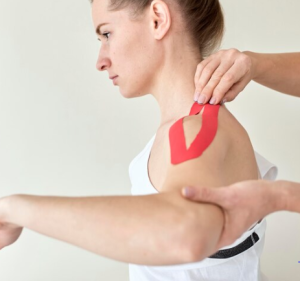What is the rotator cuff?
The rotator cuff is made up of a group of 4 muscles which control shoulder movements in all directions. Each rotator cuff muscle takes part in a slightly different anatomical shoulder movement like flexion, abduction, or rotation. In addition, they are all used in combination for movements like sport=specific movements. For example, in overhead, throwing, and racket sports such as badminton, tennis, volleyball and basketball.
The 4 muscles involved in the rotator cuff are as follows:
1) Supraspinatus
2) Infraspinatus
3) Teres major, teres minor
4) Subscapularis
What is rotator cuff tendinitis?
Rotator cuff tendinitis usually means there has been overuse/repetitive strain of the one of the tendons or group of tendons of the muscles listed above. As a result, inflammation has developed in that tendon, causing pain and loss of function. This condition may start as mild pain at the beginning but if left ignored and untreated, can worsen quickly and affect your ability to participate in sports.
How do I know if I have this condition?
The following are a list of the most common signs and symptoms:
1) Pain, discomfort, soreness, tightness with shoulder movement
2) Certain angles of shoulder movement reliably recreate the sharp pain. E.g. picking up a glass of water, overhead activities, reaching the arm backwards to put a jacket on
3) Stiffness in shoulder, especially in the morning
4) Sleeping discomfort while sleep on the affected side
5) Swelling in or around the shoulder
6) All overhead activities- painful, sharp pain and may radiate pain down the arm
If this list matches your symptoms, we recommend coming in to be assessed by a health care professional. Our physiotherapists are experts with shoulder pain and can help you understand your condition.
Is it possible to prevent tendonitis?
Yes, proactive and mindful care/training can reduce your chances of developing tendonitis.
Regular stretches and a proper warmup before playing sports always helps in prevention of injuries. There are various kinds of stretches to choose from like static, dynamic, yoga, deep tissue or foam roller stretches. Additionally, strengthening exercises and mobility work of the shoulder and thoracic spine are essential. The muscles must be strong enough to keep up with the high amount of force they withstand during play. Finally, ensuring that you are taking sufficient rest is equally as important. Many injuries are the result of increasing activity levels too quickly and the body fails to adapt.
How is rotator cuff tendinitis treated?
Rotator cuff tendinitis is best treated conservatively, with the help of a physiotherapist. While some people may benefit from medical intervention, most people are successful with athletic rehabilitation and sports therapy.
1) Rest: Avoiding over-exercising will prevent the condition from worsening and allow the muscles to recover and helps in healing.
2) Stretching: Stretching the major shoulder joint muscles can reduce the stress on the rotator cuff and also increases the flexibility of the muscles.
3) Modalities: Electrotherapy like TENS, IFC and/or ultrasound will help reduce pain and inflammation.
4) Pendulum exercise: This helps in preventing shoulder stiffness by increasing space at the joint and also maintains the mobility of the joint. This can be modified with adding more weight like carrying a dumbbell in your hand while performing it.
5) Joint mobilization: Working on the shoulder joint can reduce inflammation, pain, and help improve range and quality of motion of the shoulder.
6) Range of motion exercises: Various ROM exercises with or without assistance, depending on pain levels and current function ex. with the help of a cane, wall, or pulley to off weight the arm and help regain lost ROM in the shoulder.
7) Strengthening training: Depending on the specific condition or based on an individual’s current strength, resistance training can be done using weights and resistance bands to strengthen the rotator cuff.
8) Functional training: This includes working on the daily activities you may have trouble with, such as lifting a bag or throwing a ball using proper shoulder mechanics. This type of training prepares you to return to your normal activities, including preparing for return to sport.
Looking for athletic therapy?
Whether it’s your shoulder or another injury limiting your ability to participate, PhysioNow can help! We offer sports physiotherapy for athletes, with experience treating a wide variety of sports injuries. Our sport physiotherapists are ready to help you get back into play. Book with PhysioNow today for your first assessment and treatment!






Leave a Reply